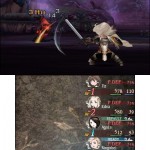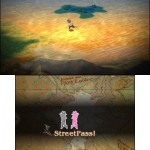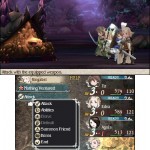 If you enjoy classic turn-based JRPGs, you want Bravely Default. If you don’t, you’ll still want it anyway. Bravely Default is a wonderful mix of the best features in traditional RPGs, and modern technological features and tweaks that make the game accessible and fun. This game feels familiar, in the best possible way, while avoiding feeling stale, or rehashed. It’s a modern game with the mechanics and feel of the kind of RPGs that many have enjoyed for years, but it’s fresh, and fun. It’s also Final Fantasy. There’s no mistaking it.
If you enjoy classic turn-based JRPGs, you want Bravely Default. If you don’t, you’ll still want it anyway. Bravely Default is a wonderful mix of the best features in traditional RPGs, and modern technological features and tweaks that make the game accessible and fun. This game feels familiar, in the best possible way, while avoiding feeling stale, or rehashed. It’s a modern game with the mechanics and feel of the kind of RPGs that many have enjoyed for years, but it’s fresh, and fun. It’s also Final Fantasy. There’s no mistaking it.
Many of the features of Bravely Default can be found in classic RPGs, especially those in Final Fantasy, such as the turn-based battle and job systems. Spells and items share the same names, and familiar keystones of the series – crystals, airships, even some of the monsters – can be found. The world is rich, and beautiful, and seems to be alive. It feels like it has a history, just like the game itself does. Even though it is a brand new series, Bravely Default is part of a tradition.
The battle system is turn-based with a twist. You can attack or use abilities in the traditional manner. Alternately you can choose Brave, and use a few of your next attacks all in one turn. The penalty for this being you have to sit it out afterwards and wait for your opponents to attack a number of extra times. Or you can Default, defending yourself and taking less damage, but remaining inactive and saving your actions for later. Strategy is key here: do you attack as soon as possible and hope you’re victorious, or wait and strike when the moment is perfect? You can gain bonus experience if you win in one round, or make it through the entire fight unscathed. You can also use customizable special attacks that are available to fire off when you meet special conditions (such as using Brave a certain number of times). In the heat of battle, you can summon friends or guests from across the internet to appear and help you out of dangerous situations by attacking your enemies or healing you. Especially strong friends can help out a lot.
You can choose what job you want your character to be: swordmaster, valkyrie, monk, ninja, various colored mages, and many others. Job “asterisks” are won in boss battles, and they unlock new jobs for your party. Each job has its own abilities and spells, and characters are customizable with various abilities from different classes, making the job system extremely flexible. Each job also has a special affinity for specific weapons. Their favored weapons will do the most damage. Choose wisely.
I won’t give much detail of the plot, so as not to spoil the story, but an element of the game is rebuilding a ruined town. The same friends and guests you can summon in battle can be assigned to build and upgrade shops, and clear rubble to open access to new areas of the town. Each time a shop is upgraded, you gain access to a new piece of equipment, item, or stat boost for your special attacks. Upgrades take time. Some take many real-world hours, but you can assign multiple friends, and the more you allocate, the less time each upgrade takes. Strategically choosing what upgrades you’d like to perform when, and how many friends you assign to each is a major part of the rebuilding. Certain items you unlock can really help early in the game, so it’s better to get some things as soon as possible. Shopkeepers will regularly give you items as gifts, which is a nice incentive to upgrade their shops. This rebuilding aspect of the game is really interesting and fun, and I often found myself rushing to check on the town as soon as i woke up to reassign my townspeople to bring my shops to the next level, and I make sure to do the same before bed, to get those really long upgrades started.
Bravely Default allows you to extensively customize your experience when it comes to difficulty. You can choose the difficulty, turn off objective markers, choose whether or not you gain certain types of experience, etc. The amount of random battle encounters can be increased or decreased, or even turned off completely! This is such a welcome feature. The game will warn you that you’ll have a tough time gaining experience if you turn random encounters off, but it’s great for backtracking through areas you’ve been through where weak enemies would otherwise waste your time every few steps. Battles can be automated. Command your party to do what you want them to, hit Y and let them go. The D-pad can even be used to fast forward animation. Combine this with the auto battles, and low level random encounters are a breeze.
The graphics are pretty. The characters are drawn in a semi-“chibi” style, and look much younger than they are, but the design is quite charming, and every job has its own unique costume. Towns are heavily detailed, and full of shops and people to talk to, and backgrounds in and out of battle look great. With augmented reality cards, you can watch scenes featuring large 3D models that act out scenes in the room with you, which is more fun than I would have expected.
Music in Bravely Default is wonderful, and sound in general is really enjoyable. However, I played the game with English voices, and the acting is hit or miss. Some of the voices are very well-acted (I particularly like Edea), but some are a bit stiff or slightly awkward. Also the quality of the voice files were a little poor, with some noticeable hissing, but this is probably a necessity of storage space. But these are small issues. Overall the sound design is great.
For fans of old-school (or new-school) turn-based JRPGs, this game is a necessity. For those on the fence, check out Bravely Default. It’s a really enjoyable game, with a nice battle system, a lot of customization with many jobs and abilities, beautiful art and music, and likeable characters. It’s a game worth anyone’s time.
Gameplay
Graphics
Sound
Overall





